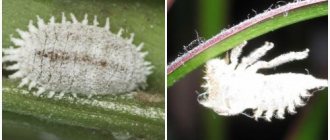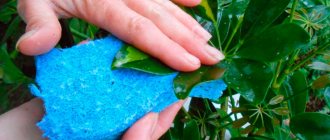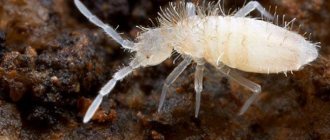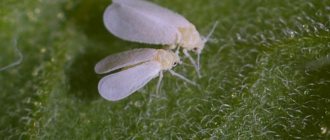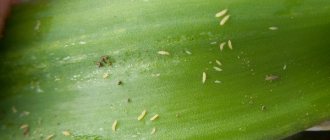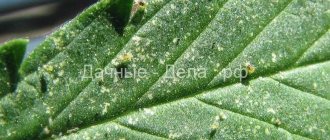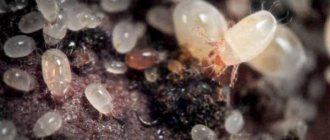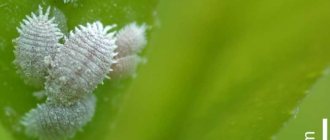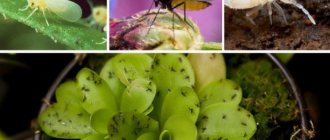One of the dangerous pests of indoor plants is the root bug, which is very difficult to detect in the early stages of its spread. As a rule, only replanting flowers allows you to see the white fluff on the roots, which indicates the presence of a pest. But at this time there are already too many parasites. Therefore, it is very important to detect the pest in a timely manner and take appropriate measures to combat it.
Features of the root mealybug
The homeland of the root mealybug is America. Over time, he “moved” to Western Europe, and after some time he was discovered in Eastern Europe. Saintpaulias, or violets, suffer the most from this pest. The blind and American scale insects are capable of destroying both succulent plants and Saintpaulias in a short time. More than 30 species of such scale insects have been found in America. These pests pose a serious threat to many plants. The fact is that they are polyphagous, which means that they can settle and feed on various plants.
Over the long period of their existence, root scale insects have undergone significant evolutionary changes. Now they live exclusively underground, and as food they use plant juices, which they extract from the roots. Such scale insects are especially dangerous because in the initial stages of infection it is impossible to understand that they are in the ground. And after the pest is found, the bushes will suffer greatly. The fact is that it can only be detected during plant transplantation.
The larvae and females of this pest are constantly in the soil, and they use the roots of a variety of plants as food. Very rarely, pests settle on the stem of a plant at a height of 0.1–0.5 cm from the soil surface. In this place, a whitish coating forms, which looks more like fluff. Such plaque is the secretions of the pest. The body of the female has a cylindrical shape, yellowish-white color, its surface is covered with a layer of waxy coating. She leads a relatively sedentary lifestyle. To raise offspring, females create special chambers from their secretions, which look like fiber. They make cameras in the immediate vicinity of the roots, in voids, and also in a pot on the edge of the substrate. Externally, the masonry of the root worm looks like simple mold.
The male is similar in appearance to the whitefly, but is much smaller. It also differs from the female in its fragility: the adult stops eating and dies after a short time. As a result, entire generations were observed throughout the year in which there was not a single male.
After the larva leaves the egg, it “takes care” of itself. She looks for her own food and moves quite quickly. Compared to the female, the larva has a much thicker layer of wax on its body. That is why, where the larva crawls, a trail of whitish waxy secretions remains.
If you find a small damage on the root system of a flower that was left by root scale insects, then when examined under a microscope it will look more like a huge number of larvae are swarming in the soil. Visually examining a plant affected by a root worm, you can see a waxy coating of a whitish hue on the root collar, which rises only a few millimeters above the surface of the substrate. By this sign, you can find out about the presence of a pest in the soil mixture without even removing the bush from the pot.
The pest can also be detected during the replanting process. If you were unable to detect scale insects at the initial stage of infection, then after some time the degradation of the affected plant will begin. At this time, mealybug larvae are the most dangerous because they can quickly and easily move into a nearby flower pot. Such pests multiply very quickly, so by the time you realize that one of your plants has dried out due to scale insects, other indoor flowers will already be affected by them.
To this day, scientists do not stop researching root scale insects. The fact is that they are capable of causing significant harm to valuable ornamental and economic crops. In the territory of the former Soviet Union, such pests were initially found on the roots of cacti, and they received the names: ordinary, aloe and cactus. After some time, many new varieties appeared, and the list of crops on which scale insects can settle also increased significantly.
Preventative measures to protect orchids
Here are recommendations from experienced gardeners that will help prevent infection by this pest.
Safe purchase
If you are going to buy new orchids, carefully examine the potential “tenants” and refuse to buy if you see that someone is living on the plant.
If you received an orchid as a gift, do not rush to “register” it on the windowsill with other plants. First we inspect it and, if necessary, treat it to destroy pests.
If a small mealybug infestation is noticed on the plant, you can eliminate it with neem tree oil (it will not cope with a large colony).
Regular inspection
The best protection against attacks from flower pests is regular inspection of plants for damage. The sooner you catch the insects by surprise, the sooner you will get rid of it, preventing it from multiplying and spreading to neighboring orchids.
Carefully inspect flower stalks, young leaves, orchid flowers and new shoots: they are full of amino acids loved by mealybugs.
Plants on which rootworms can settle
The root bug prefers to settle on those cultivated plants that are grown in a well-permeable substrate and at the same time react negatively to abundant watering. For example, these are crops such as succulent plants and violets (Saintpaulia). And such a pest can also infect:
- aroid crops: dieffenbachia, anthurium, monstera, alocasia;
- ficus;
- asparagus;
- citrus;
- azalea;
- Crassula, aloe, adenium, cactus, spurge, sedum, young, etc.;
- coffee;
- camellia;
- hibiscus;
- Saintpaulia, etc.
This is not a complete list. But this pest prefers to settle on these plants, since when they are grown, the most favorable conditions for mealybugs are created. However, there are many varieties of the plants listed above, and among them there are spectacular decorative flowering specimens. Most of them are incredibly similar to each other, and only specialists can distinguish them. However, all these plants have one thing in common - similar growing conditions and care. So, in the summer, the soil mixture in the pot is watered in such a way that it remains free-flowing, while in winter the crops do not need watering at all.
Appearance
Just a few decades ago, there were few varieties of root bugs, and they settled mainly on the roots of succulents. However, today more than a hundred species of this pest are known, and it prefers a dry soil mixture for development and does not betray its presence for a long time. The situation is aggravated by the fact that the root bug is very small in size and is not always visible to the naked eye.
Online course “KETOPLAN” - a personal nutrition plan for weight loss available to everyone (advertising)
Signs of plant damage by root insects
It is possible to understand that a plant is affected by root worms. The main thing is to know certain signs by which it is possible to determine the presence of a pest in the soil. If you detect the insect in a timely manner and begin to fight it, then the affected plant can be saved. In order for the plant to survive, it is recommended to replant it as quickly as possible, with a complete replacement of the substrate and pot.
You can understand that a pest has settled on the roots of a crop by the following signs:
- The bush, subject to proper care (appropriate temperature conditions, watering and soil mixture composition), completely stopped growing.
- The plant has become faded, the foliage has lost its shine and looks lifeless.
- Since the root system begins to actively die due to pests, massive yellowing of the foliage is observed, while it loses its turgor.
- A plant affected by a mealybug weakens and begins to wither not only because the pest feeds on its juices, but also because it contributes to the introduction of a special substance into the bush, which inhibits the crop.
- Damage to certain areas of the root system is observed, due to which the plant weakens and can be affected by pathogens of fungal and infectious diseases. As a result, the bush becomes lethargic and looks lifeless.
- At the very last stage of insect infestation on the bush, you can see wrinkled and drying leaf plates.
If you examine a violet that is affected by a scale insect, then on the surface of its root system you can find a gray coating that looks more like ash. And on the sides of the earthen lump you can see a thick coating of grayish-white color. If you look at Saintpaulia under a microscope, you can see that its root system is covered with many larvae. At the same time, on the very edge of the earthen clod you can see a huge number of ovipositions. And on the surface of the walls of the container in which the flower was, you can see with the naked eye the waxy secretions of root scale insects, which look very similar to cotton wool. It is unlikely that such a bush will be saved.
How to deal with it?
First of all, a plant that has been infected with scale insects is mechanically cleaned of the pest. To do this, you should prepare a soap solution with warm water, which you carefully wipe all above-ground parts of the plant: leaves on both sides, stems, flowers and fruits. Severely damaged shoots can be removed. When infested with root insects, the root system should also be treated.
To save indoor plants, you can take the following measures:
- Provide quarantine for the flower so that others do not become infected. All other plants need to be carefully examined - perhaps the insects have already become interested in them.
- A preventive inspection once a month will be useful without being affected by pests. We must not forget to look at the condition of the underside of the sheet.
- If a mealybug is found, you need to take care not only of treating the plant, but also thoroughly wash the window sill or the surrounding area, because larvae may be hiding there.
- Not only females, but also males need to fight: they are caught by hanging adhesive tapes.
But the main way to combat scale insects is to use chemical or folk remedies.
Chemicals
Three groups of insecticidal drugs are effective against scale insects:
- Intestinal. They enter the insect's body through the mouthparts. One of these products is Vermitek.
- Contact. They enter through the external integument of the pest. The treated plant should not be exposed to light, as this will cause the foliage to turn yellow. For example, this is Fozalon.
- Systemic, in which toxic substances enter the sap of plants. These are Rogor and Phosfamide sprays.
The popular products “Aktara” and “Aktellik” are combined: both intestinal and contact at the same time, which makes them more effective.
Folk remedies
Some substances with a pungent odor are harmful to scale insects. For example:
- infusion of fragrant tobacco, which the plants are sprayed with three times, waiting a week between treatments;
- garlic infusion: 5 cloves per 0.5 l. Leave for at least 4 hours;
- soap solution with alcohol (10 ml each), diluted in 1 liter of water.
Folk remedies will help if there are not many scale insects on the plant.
Scale insects are pests that can and should be combated immediately after detection. Otherwise they will harm the plants. Today there are many tools that solve this problem.
Prevention of plant damage
There are several preventive measures that will help avoid the appearance of root scale insects in the soil of indoor plants:
- Both the mixture prepared with your own hands and the purchased soil mixture must be thoroughly steamed.
- Inspect all plants regularly and monitor their development.
- Water your home crops on time. Experts advise not to overdry the earthen ball, as this creates favorable conditions for the life and development of the pest. However, this watering regime is not suitable for all indoor crops.
- Carefully monitor the condition of the soil mixture in the pot. If signs of the appearance of a scale insect have been noticed, then you need to start fighting it as soon as possible.
- Systematically inspect the entire bush, paying attention to its condition, the color and turgor of the foliage, and also do not forget to check the root collar.
- In autumn and spring, it is recommended to carry out 3 or 4 abundant waterings with complete soaking of the earthen clod. To do this, use a solution of an insecticidal preparation, for example: Allounds or Aktars. You need to pour the solution until it flows out of the drainage holes.
- During transplantation, be sure to inspect both the bush itself and its earthen lump and roots.
Other pests that attack cacti and succulents
But, unfortunately, other pests, of which there are many varieties, can also appear on cacti and succulents.
Scale insects on cacti
These pests are close relatives of scale insects. Scale insects rarely damage cacti; they often appear on other succulents. Their cover paint is clearly visible on cacti only when the colony of scale insects has grown greatly.
If there are not too many pests yet, then they can be removed manually by scraping them from the plants using swabs soaked in an alcohol solution or kerosene. If the colony of scale insects has grown greatly, then it is necessary to use appropriate pesticides.
In the photo there is a scale insect on a cactus:
Leaf-eating pests often appear on leafy succulents
. If colonies of such pests grow greatly, the plants may die completely. The methods of dealing with such pests are the same as with harmful insects that attack cacti.
Nematodes on cacti
There are several varieties of this pest that can settle on the roots or above-ground parts of cacti. These worms are too small, so their presence can be understood only by the corresponding symptoms - galls appear on the roots, or by cysts formed on the stems.
If galls are found on the roots, all affected parts must be cut off, and healthy parts of the roots are washed under running hot water.
. You also need to disinfect everything that came into contact with the soil in which there were clutches of nematode eggs.
Thrips on cacti
Cacti and other succulents can be affected by another pest - greenhouse thrips.
. The body of this pest is small - about a couple of millimeters, its color is dark brown, and its wings are fringed.
Thrips larvae do not have wings, and they feed on the cell sap of cacti, other succulents, and other indoor plants.
In the photo there are thrips on cacti:
Many pesticides that are relatively safe for humans and pets can cope with these pests.
But we should not forget about preventing the appearance of this pest on indoor plants:
- purchased plants should be quarantined;
- the nutrient soil mixture is pre-disinfected;
- carry out preventive spraying with insecticidal preparations;
- regular baths.
Aphids on cacti
Aphids are a huge disaster not only for garden and vegetable crops, but also for indoor plants. It multiplies quickly and feeds on cell sap, which weakens cacti and other succulents.
You can fight aphids on cacti in the following ways:
- mechanical
- washing them off with strong water pressure; - biological
- treatment with an infusion based on onion peels or other plants, or by attracting biological enemies of aphids to plants; - chemical
- use pesticides for spraying.
In the photo there are aphids on cacti:
Red cockroaches
These insects, settling in a house or apartment, can feed on everything - from food debris to flowers, shoots or seedlings of indoor plants.
To prevent indoor plants from being attacked by these insects, you just need to remove cockroaches from the room.
How to feed houseplants and indoor flowers in winter
Control measures
If a mealybug settles on a house plant, you can notice it with the naked eye and begin to fight it in a timely manner, since it lives and feeds on the surface of the substrate and the plant. The root bug lives on the roots and in the soil mixture, so it is not easy to detect. As a rule, it is possible to understand that a pest has settled on a bush only during replanting. Most often, the plant is already severely damaged, and it is extremely difficult to fight the pest. However, it is still possible to save the bush.
Folk remedies
Since root bugs are extremely dangerous for many crops, it is recommended to immediately use chemicals to combat them, because folk remedies do not give a 100% result. However, experts still recommend resorting to a hot root bath; the technology for doing it is quite simple:
- Immerse the plant's root system in a container of hot water (no higher than 55 degrees) and wait 15 to 20 minutes. Then pull out the bush and wait until it dries well, this usually takes from 15 to 20 hours. After the root bath, it is recommended to plant the plant in a new pot and fresh soil mixture.
- Carefully remove the plant from the container along with the earthen lump.
- Rinse the root system thoroughly to completely remove the substrate from it.
- Wash the container well with a detergent solution and pour boiling water over it. If you wish, you can simply throw it away and buy a new pot.
- Using a sharp tool, cut out any injured areas on the roots.
- Rinse the root system thoroughly with the Acaricide solution.
- For planting, use fresh, disinfected soil mixture.
- Plant the bush in a new container and substrate.
- Place the transplanted plant away from other flowers. The fact is that the larvae move extremely quickly and can easily climb into a flower pot located nearby.
Traditional methods
There are several folk methods that often give effective results in the fight against mealybugs.
- If the infection is mild, you can use the peels of citrus fruits, which are infused in water for several days;
- spraying with an alcohol solution of soap gives good results for any form of infection . To do this, one teaspoon of crushed soap is dissolved in a small amount of boiling water. Mix the solution with one tablespoon of alcohol and one liter of water. Before spraying, the soil in flower pots is covered. Instead of spraying, you can wash the plant with a piece of cotton wool, changing it periodically so as not to spread insects throughout the plant. After a day, you need to rinse the plant under running warm water;
- You can use garlic infusion for processing. Garlic in the amount of 50 grams is crushed, poured with one liter of hot water and infused for about six hours. After this, the infusion is filtered and sprayed;
- Spraying with horsetail decoction, which can be purchased at a pharmacy and brewed according to the instructions, helps well in the fight against these insects;
- You can apply spraying with added oil. Add two tablespoons of olive oil to one liter of warm water.
All treatment methods are applied after clearing the plants of visible insect infestations.
